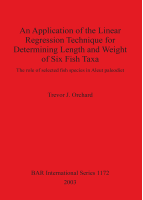Description
BOOK DESCRIPTIONThe detailed estimation of the original live size of faunal specimens from archaeological assemblage provides a particularly useful, though generally under-employed, tool for zooarchaeological analysis. Though a variety of methods have been employed in the generation of such size estimations, statistical regression provides perhaps the most accurate estimations of the original live length and weight of fish specimens found in archaeological contexts. Such estimations are useful for the reconstruction of diet and the investigation of past environments. Furthermore, detailed size estimations can contribute to a refinement of other methods of faunal quantification, such as the calculation of minimum numbers of individuals (MNI). Statistical regression was applied to the comparison of skeletal element size and the live length and weight of six fish taxa: Pacific cod (Gadus macrocephalus), Walleye pollock (Theragra chalcogramma), Atka mackerel (Pleurogrammus monopterygius), Greenling (Hexagrammos sp.), Rockfish (Sebastes sp.), and Irish Lords (Hemilepidotus sp.). For each taxon, a selection of skeletal elements were measured from comparative specimens and these data sets used to generate regression formulae which compared the known live length and weight to specific skeletal element measurements. This resulted in the creation of a easily applicable tool for the estimation of the live size and weight of skeletal specimens from archaeological contexts. This methodology was tested in the context of a case study involving the analysis of fish remains from five archaeological sites in the Aleutian archipelago. Specifically, this included two sites on Adak island, a single site on Buldir island, and two sites on Shemya Island, providing a sample that spans the central and western parts of the Aleutian chain. In the assessment of the relative contributions of the taxa under consideration to the diet of the prehistoric inhabitants of these sites, the regression approach was shown to produce superior results to those obtained through traditional meat weight calculations. The results of this analysis also provide insight into temporal changes in the local environment and ecology.











